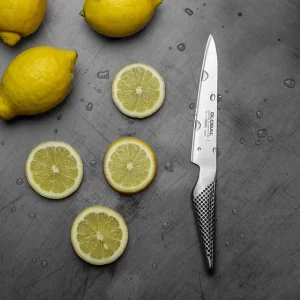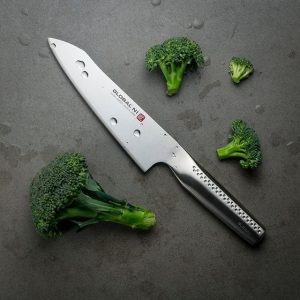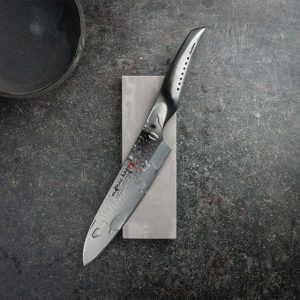Global Classic

The G-2 chef’s knife looks the same today as when it was launched over 30 years ago, which is proof that it has a really good design. The knife is made from a layer of Cromova 18 steel. To give the knives a perfect balance in the hand, the handles are filled with sea sand. First, the knife caught on with the professional chefs, then the home cooks followed. Today, Global is an immensely popular knife brand, both in Sweden and around the world.
Global NI

The knives are made of a layer of Cromova 18 steel (like the classic Global knife) but are slightly thicker. They have been given an extreme sharpness and are sharpened by hand by a master sharpener. The handle has a slightly larger shape than the classic Global knives but with a more tapered design for a perfect ergonomic grip. The well-known “Global dots” are characterized here by a bright and elegant design. To give the NI knives a perfect balance in the hand, the handles are filled with sea sand.
Global SAI

Global SAI is a three-steel knife with hard-hardened steel in the edge and softer steel that surrounds the hard steel, which gives a knife with fantastic properties. The handle is ergonomic and comfortable to hold. The distinctive “Global dots” are of course still there, albeit in a slightly more discreet design. To give the Sai knives a perfect balance in the hand, the handles are filled with sea sand.
BACKGROUND
The sword
There is a jungle of kitchen knives on the market and it is not always easy to choose. A group of knives that stand strong on the Swedish market is Japanese knives. So what is it that makes Japanese kitchen knives so special and talked about?
The sword or Katana has always had a special role in Japanese culture. The infamous samurai warriors used Katana as early as the 7th century. The blacksmiths usually used Japanese Tamahagane steel, which in itself is a very soft steel, but by folding it 16 times to clean out impurities, also called damasking, you got a much harder steel. It was here, then, that the Japanese art of blacksmithing developed and acquired its distinctive features.
In the 19th century, the Katana was banned when Japan opened its trade routes to the US and the West. The blacksmiths still had to make a living somehow and that’s when the production of kitchen knives took off. The Japanese kitchen knives inherited the hardness and sharpness of sword steel.
The Japanese food
In Japanese food, there has always been a great focus on the actual cutting of raw materials. Sushi and Sashimi, for example, are two dishes that are based to a very large extent on how to cut up the various ingredients. Precision in the work becomes incredibly important in the Japanese kitchen. But whether it is the knives that have influenced the food culture or the food culture that has influenced the knives is difficult to answer. Given the long knife tradition, the first-mentioned option is not at all unthinkable. Even today, the work of making knives in Japan is a solid craft that requires a lot of time and effort. Mass production is thus more of an exception than a rule.
In the 80s, the knife brand Kyocera came up with an alternative to the classic steel knives; ceramics. Ceramic is harder than steel and therefore allows a sharper edge of the knives but at the same time a greater fragility.
When Japanese knives have spread all over the world and to the West, they have both inspired Western knives but also taken inspiration from them. Global knives are an example of Japanese knives with a slightly more western look. Also, Zwilling, Kyocera, Mac, Wusthof, and Miyabi are some brands that mix both Western and Japanese traditions in their knives. A traditional Japanese knife has a straight handle that is rounded or has eight edges.
The blade is only sharpened on one side, while a Western one is symmetrically sharpened, i.e. sharpened on both sides of the blade. The asymmetric sharpening can give the edge a sharper angle, which in turn allows for a sharper knife. This places higher demands on the sharpening and maintenance of Japanese knives, which are easily destroyed if they are sharpened incorrectly.
THE DIFFERENT MODELS
In the Japanese knife flora, there is a plethora of different kinds of knives. Some of the most common are:
Gyoto (chef’s knife)
If you only want one knife, this is the model for you. This knife is what chefs usually refer to as a chef’s knife. It is a versatile knife with a blade length of 18 cm and up. The hallmark of this knife is a good height in the blade and a slightly upward curved profile.
Santoku (Japanese knives)
The Santoku knife is perhaps the most common of Japanese knives. “San” means three in Japanese and “Toku” roughly tasks, which can be interpreted as a santoku knife being suitable for three tasks; dice, shred, chop, or meat, fish, and vegetables. In other words, it is a very versatile knife. A santoku is usually between 14 and 18 cm long.
Nakiri (vegetable knife)
The distinctly straight profile of a Nakiri is unmistakable. With its straight blade, a Nakiri hits a large part of the ground at the same time. This makes the knife almost unbeatable for chopping large quantities of vegetables and similar raw materials, which require a lot of chopping.
Sujihiki (Carving Knives)
A long blade is a prerequisite when tranching. A narrow blade easily releases from the raw material you are cutting. Sujihiki is the Japanese name for truncation knife or pre-slicer. The steak, salmon, or ham handles this knife with pleasure.
Kiritsuke/Bunka
This knife has a very pointed tip, which makes it good to work precisely with because you can always see the tip when cutting. The cutting profile of the blade is most reminiscent of a Gyoto. The short version of this model is called Bunka, while the longer one is often called Kiritsuke.
Petty / Utility (small knife)
Petty is the name for small kitchen knives. At approx. 10 cm and above, the knife is often called Utility. What the small knives have in common is that they are used for precision work, often free in the air without the cutting board.
Bird’s beak (Pruning knife)
A name that speaks of the shape of this small paring kitchen knife. The knife also goes by the name Petty.

Leave a Comment